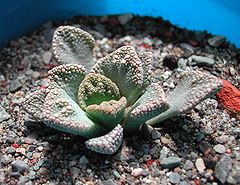Titanopsis
| Titanopsis subsp. var. | ||||||||||||||||||||||||||||||||||||||||||||||||||||||||
|---|---|---|---|---|---|---|---|---|---|---|---|---|---|---|---|---|---|---|---|---|---|---|---|---|---|---|---|---|---|---|---|---|---|---|---|---|---|---|---|---|---|---|---|---|---|---|---|---|---|---|---|---|---|---|---|---|

|
|
| ||||||||||||||||||||||||||||||||||||||||||||||||||||||
| ||||||||||||||||||||||||||||||||||||||||||||||||||||||||
Titanopsis is a genus of about 10 species of succulent plants of the family Aizoaceae.
The name "Titanopsis" comes from the ancient greek "titanos" (=limestone) et "opsis" (=looking like)
They come from South Africa (Bushmanland, Upper Karoo)
They are small plants, with rosette up to 10 cm high.
Leaves are up to 3 cm with truncate tip and rough little tubercles at the apex of the leaves. They look like limestone and are hard to be seen in the wild.
Yellow flowers with 2 cm diameter appear in late fall.
Cultivation
The plants are calcicole (=they appreciate calcaire soils)
The plants need well drained soil and sunny exposure. Few watering in summer and not at all in winter
Division of larger clumps is the easiest way of propagation. Seed is also possible.
Cultivation is difficult because they fear watering excess.
Propagation
Pests and diseases
Species
List of species:
- Titanopsis calcarea, the most known species
- Titanopsis hugo-schlechteri
- Titanopsis schwantesii
Gallery
References
External links
- w:Titanopsis. Some of the material on this page may be from Wikipedia, under the Creative Commons license.
- Titanopsis QR Code (Size 50, 100, 200, 500)
